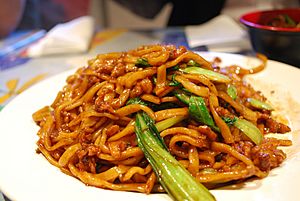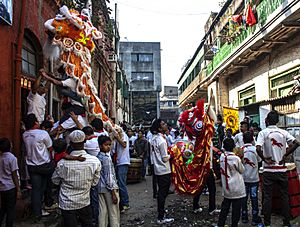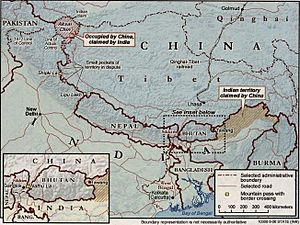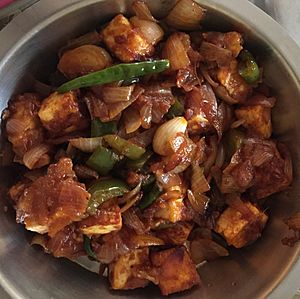Indian Chinese cuisine facts for kids
Indian Chinese cuisine is a special mix of Indian and Chinese flavors. It's also called Indo-Chinese or Chindian food. While these two cuisines have mixed for a long time, the most popular story of this food style began in Kolkata, India. About 250 years ago, Chinese people moved to colonial India for new chances. They opened restaurants and changed their cooking to fit what Indian people liked.
Indian Chinese food uses Indian vegetables and spices. It also uses lots of tasty Chinese sauces, thickeners, and oil. Chefs often stir-fry the food in a wok. This way, Chinese cooking styles get a spicy, flavorful Indian twist. This delicious food is now very popular in India, Pakistan, Bangladesh, and Afghanistan. It has also spread to countries like America, Britain, and Canada. This has changed how people around the world see Chinese, Indian, and Asian foods.
Contents
How Indian Chinese Food Started
Chinese People Arrive in India
The most common story about Indian Chinese food starts with Chinese people moving to Calcutta (now Kolkata). Calcutta was the capital of British-ruled India. It was a great place for new opportunities. This drew many workers and business people from nearby areas. Calcutta was also easy to reach from China by land.
The first Chinese settler was a man named Tong Atchew. He came in 1778. He started a sugar mill near Kolkata with Chinese workers. After him, many more immigrants came from the Guangdong province of China. They left their homes because of difficult times and looked for safety and a better life.
Many Hakka Chinese became cobblers and tanners. Cantonese people often worked as carpenters. People from Hubei became dentists. But a very popular job for all groups, especially for wives, was running a restaurant.
These early settlers created Chinese communities. They cooked and ate foods from their homeland. These Canton cuisines were known for being light and fresh in China. But they started to change in India. One reason was that the ingredients and spices were different. This made the flavors naturally become more Indian. Also, Chinese restaurants began to cook food that Indian customers would like. They used more spices and more sauce and oil than traditional Chinese cooking.
One of the first Indian Chinese restaurants was Eau Chew. It became popular by mixing exciting Chinese food with familiar Indian flavors. These included chili, curry, and corn starch. Today, Kolkata has the only Chinatown in India, called the Tiretti Bazaar. But you can find these "Chinese" foods in almost every city in India. They are sold in restaurants or by roadside vendors. This spicy, stir-fried food is very popular across the country.
Other Ways Indian Chinese Food Started
Indian Chinese food also came from other meetings of cultures. These include the Silk Road, old connections, and geography. All these things helped bring the cooking styles and flavors of India and China together.
The Silk Road and Cultural Exchange
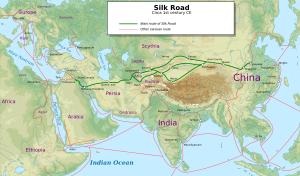
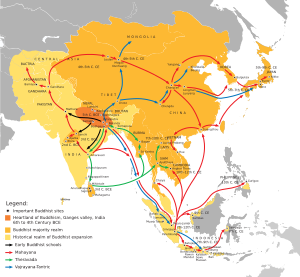
The Silk Road was a network of trade routes on land and sea. It was used from 130 BCE to 1453 CE. It stretched from China and the Indonesian islands through India and the Middle East, all the way to Africa and Italy. This route was very important in ancient history. Goods, ideas, and even diseases traveled between the East and West.
Chinese and Indian merchants traded goods across their borders. Silks, rice, and crockery came from China. Many important spices came from India. Another exchange was religion. Buddhism came to China from India through the Silk Road. As Indian culture mixed with Chinese traditions, the Mahāyāna Buddhist religion was formed. Just as Chinese people adapted Buddhist ideas, both cultures adopted parts of each other.
For example, you can find rice dishes cooked in Indian-style Chinese woks in southern India. Also, spices like ginger, cinnamon, and black pepper are in some Chinese dishes. This shows how the Silk Road helped bring the two cultures together. Indian and Chinese food styles mixed hundreds of years ago. So, Indian Chinese food might have started long before the first Chinese settlers in Kolkata.
Influences on Southeast Asian Cooking
India and China are neighbors. Both are ancient empires and two of the most populated countries today. Since the second century CE, Indian rulers governed Southeast Asian countries. Chinese rulers governed eastern regions like Vietnam. Southeast Asia also had many immigrants from China and India.
You can see Chinese and Indian influences in the foods of Southeast Asia. The Chinese way of growing rice came to Southeast Asia and Nepal around 3000 BC. It has been a main food there ever since. Chinese cooking tools like spoons, chopsticks, and woks also came to the region.
Indian influence can be seen in the spices and flavors. Curries started in India. They are meat, fish, or vegetables cooked in a spiced sauce with rice or bread. Curries have spread throughout Asia. Spices like turmeric, coriander, pepper, and ginger are in curries across Southeast Asia. Countries like Indonesia, Malaysia, Thailand, and the Philippines have strong ties to Indian-style curry flavors. So, Southeast Asian cuisine itself is another example of Indian Chinese food origins.
Food Spreading Across Borders
China has also been influenced by Indian spices, especially in Tibet. Nepal also has cooking styles from both its Chinese and Indian neighbors. So, another origin of Indian Chinese food can be found in the cultures of Nepalese and Tibetan peoples. Their lands are mostly between India and China.
The simple foods of Nepal are often served with rice. They include curries or spiced vegetables stir-fried or boiled in an Indian-style wok called a karahi. Tibetan food is influenced by its neighbors: Nepal, India, and China. Tibet is also heavily influenced by Indian Buddhist values. With beliefs and ideas, culture and food also travel.
Noodles and teas from China are important in Tibet. Brown mustard comes from India. The "momo" dumpling dish is shared with Nepal. All these are key parts of Tibetan cuisine. As ingredients and cooking styles spread across borders, the regions of Nepal and Tibet (and Bhutan) developed cuisines that mix Chinese and Indian styles. This created another way Indian Chinese food began.
What Makes It Special
Indian Chinese dishes often use spices like cumin, coriander seeds, and turmeric. These spices are not usually found in traditional Chinese food, except for a few areas like Xinjiang. Hot chilli, ginger, garlic, sesame seeds, dry red chilies, black pepper, and yogurt are also used a lot. This makes Indian Chinese food taste similar to many dishes in Southeast Asian countries like Singapore and Malaysia. These countries also have strong Chinese and Indian influences.
Most main dishes come with lots of gravy. But you can also order them "dry" (without gravy). Popular cooking styles in Indian Chinese food include:
- "Chilli": This means batter-fried food cooked with pieces of chili pepper.
- "Manchurian": This means a sweet and salty brown sauce.
- "Schezwan": This means a very spicy red sauce.
Popular Dishes
The main ingredient in these dishes can often be changed. You can use other meats, vegetables, or paneer. The name usually tells you the main ingredient first, then the style. For example, "Chicken Chilli." Many dishes come in "dry" or "gravy" versions.
Appetizers
- Chicken lollipop - A tasty chicken snack.
- Hot and sour soup - A soup that is both spicy and tangy.
- Manchow soup - A vegetable or chicken soup.
Main Dishes
- Chilli chicken: Can be dry or with gravy.
- Garlic chicken
- Chilli Paneer: A spicy dish with Indian cheese.
- Schezwan dishes: These are very spicy dishes. They use a sauce made with dry red chilies, garlic, and spices. These dishes are often quite different from those found in China's Sichuan Province.
- Ginger chicken
- Manchurian: This dish usually has deep-fried meats or cauliflower (called gobi). It's served with vegetables in a spicy brown sauce. This dish was created in Chinese restaurants in India. It's said that Nelson Wang invented it in 1975. He used Indian ingredients like garlic, ginger, and green chilies. Then he added soy sauce, cornstarch, and chicken. A popular vegetarian version uses cauliflower, called gobi manchurian. You can also find mushroom, paneer, or baby corn Manchurian.
- Chow mein: A popular dish with noodles, vegetables, scrambled egg, ginger, garlic, soy sauce, and chili sauces.
- Hong Kong Chicken
- Jalfrezi Chicken
- Lemon chicken
- Hunan chicken
- Sweet and Sour Chicken: Different from the American version, but similar to General Tso's Chicken.
- Chop suey: American style & Chinese Style. This has crispy noodles with vegetables, chicken, or meat and sauces.
Rice and Noodles
For an Indian Chinese meal, you can choose chicken, shrimp, or vegetable versions of "Hakka" or "Schezwan" noodles, often called chow mein. You can also have regular or "Schezwan" fried rice. Some restaurants even offer spring rolls and "Schezwan" dosas.
Sweets and Desserts
Indian Chinese desserts include ice cream on honey-fried noodles or date pancakes.
Where to Find It
Indian Chinese food is easy to find in big cities in India like Kolkata, Mumbai, Pune, Chennai, Hyderabad, and Delhi. You can also find it in many towns and at dhabas (roadside stalls) along major Indian roads. Many restaurants have a Chinese section on their menus, and some only serve Indian Chinese food. You can also find it from mobile kitchen carts on city streets.
In 2007, Chinese cuisine was India's favorite food after local dishes. It was growing by 9% each year. Young people love to eat it when they go out. It's also the second favorite for families dining out, after South Indian food.
Many Indian restaurants in Western countries and the Middle East also serve Indian Chinese food. This helps Indians living abroad feel a nostalgic connection to home. This cuisine is also becoming popular in big cities in North America, like New York City, Toronto, and Vancouver. Chinese food in Nairobi, Kenya, is often in this style too. You can also find it in Australia, especially in Sydney and Melbourne. In many of these places, the restaurants are called Hakka Chinese. This usually refers to the owner's background, as many Chinese restaurant owners in India were of Hakka origin.
See also
 In Spanish: Gastronomía sino-india para niños
In Spanish: Gastronomía sino-india para niños


